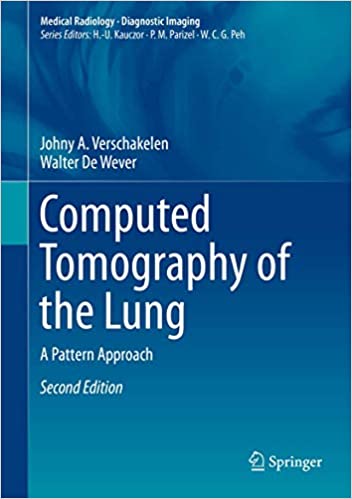Computed Tomography of the Lung: A Pattern Approach aims to enable the reader to recognize
and understand the CT signs of lung diseases and diseases with pulmonary involvement as a sound basis
for diagnosis. After an introductory chapter, basic anatomy and its relevance to the interpretation
of CT appearances is discussed. Advice is then provided on how to approach a CT scan of the lungs,
and the different distribution and appearance patterns of disease are described.
Subsequent chapters focus on the nature of these patterns, identify which diseases give rise to them,
and explain how to differentiate between the diseases.
The concluding chapter presents a large number of typical and less typical cases that
will help the reader to practice application of the knowledge gained from the earlier chapters.
Since the first edition, the book has been adapted and updated, with the inclusion of many new figures and
case studies.
Contents
Introduction
Basic Anatomy and CT of the Normal Lung
1 Introduction
2 Basic Anatomical Considerations
2.1 Anatomic Organisation of the Airways and Airspaces
2.2 Anatomic Organisation of the Blood Vessels
2.3 Anatomic Organisation of the Lymphatics
2.4 The Pulmonary Interstitium
2.4.1 Peripheral Connective Tissue
2.4.2 Axial Connective Tissue
2.4.3 Parenchymal Connective Tissue
2.5 The Subsegmental Structures of the Lung and the Secondary Pulmonary Lobule
2.5.1 Primary Pulmonary Lobule
2.5.2 Acinus
2.5.3 Secondary Pulmonary Lobule
3 Relationship Between Anatomy and Distribution of Disease
4 CT Features of the Normal Lung
4.1 Large Arteries and Bronchi
4.2 Secondary Pulmonary Lobule
4.3 Lung Parenchyma
References
How to Approach CT of the Lung?
1 Introduction
2 Analysis of Patient Data
3 Appearance Pattern of Disease
3.1 Increased Lung Attenuation
3.2 Decreased Lung Attenuation
3.3 Nodular Pattern
3.4 Linear Pattern
3.5 Combination of Patterns
4 Localisation and Distribution of Disease: Distribution Pattern
References
Increased Lung Attenuation
1 Introduction
2 Types of Increased Lung Attenuation Patterns
2.1 Ground-Glass Opacity
2.1.1 Ground-Glass Opacity Caused by a Volume Reduction of the Airspace
2.1.2 Ground-Glass Opacity Caused by Partial Filling of the Airspace
2.1.3 Ground-Glass Opacity Caused by an Increase in Parenchymal Perfusion
2.1.4 Ground-Glass Opacity Caused by Thickening of the Parenchymal Interstitium and of the Alv
2.1.5 Acute Versus Subacute or Chronic Disease
2.1.6 Crazy-Paving Pattern
2.2 Lung Consolidation
2.3 Increased Lung Attenuation Greater than Soft Tissue Density
3 Distribution Patterns and Diagnostic Algorithm
References
Decreased Lung Attenuation
1 Introduction
2 Types of Low-Attenuation Patterns
2.1 Hypoperfusion and Mosaic Perfusion
2.2 Air Trapping
2.3 Cystic Lung Disease
2.4 Pulmonary Emphysema
3 Distribution Patterns and Diagnostic Algorithm
References
Nodular Pattern
1 Introduction
2 Types of Nodular Opacities
2.1 Airspace Nodules
2.2 Interstitial Nodules
2.3 Nodules with a Density Greater Than Soft Tissue
3 Distribution Patterns and Diagnostic Algorithm
3.1 (Peri)lymphatic Distribution
3.2 Centrilobular Distribution
3.3 Centrilobular Distribution with a Tree-in-Bud Pattern
3.4 Random Distribution
3.5 Diagnostic Algorithm (Fig. 23)
References
Linear Pattern
1 Introduction
2 Types of Linear Opacities
2.1 Septal Lines (Fig. 1)
2.2 Intralobular Lines (Fig. 7)
2.2.1 Intralobular Reticular Pattern
2.2.2 Centrilobular Branching Lines
2.3 Subpleural Interstitial Thickening (Fig. 18)
2.4 Proximal Peribronchovascular Interstitial Thickening (Fig. 21)
2.5 Irregular Linear Opacities and Parenchymal Bands
2.6 Honeycombing Pattern
3 Distribution Pattern (Fig. 27 (Table 6))
References
Combined Patterns
1 Introduction
2 Combination of Pulmonary Emphysema and Lung Consolidation
3 Honeycombing
4 Mosaic Pattern: Mosaic Attenuation, Mosaic Perfusion, Mosaic Oligaemia
5 Crazy-Paving Pattern
6 Nodular and Cystic Lung Disease
7 Halo and Reversed Halo Sign
8 Combined Pulmonary Fibrosis and Emphysema (CPFE)
References
Case Study
1 Case 1
1.1 Discussion
2 Case 2
2.1 Discussion
3 Case 3
3.1 Discussion
4 Case 4
4.1 Discussion
5 Case 5
5.1 Discussion
6 Case 6
6.1 Discussion
7 Case 7
7.1 Discussion
8 Case 8
8.1 Discussion
9 Case 9
9.1 Discussion
10 Case 10
10.1 Discussion
11 Case 11
11.1 Discussion
12 Case 12
12.1 Discussion
13 Case 13
13.1 Discussion
14 Case 14
14.1 Discussion
15 Case 15
15.1 Discussion
16 Case 16
16.1 Discussion
17 Case 17
17.1 Discussion
18 Case 18
18.1 Discussion
19 Case 19
19.1 Discussion
20 Case 20
20.1 Discussion
21 Case 21
21.1 Discussion
22 Case 22
22.1 Discussion
23 Case 23
23.1 Discussion
24 Case 24
24.1 Discussion
25 Case 25
25.1 Discussion
26 Case 26
26.1 Discussion
27 Case 27
27.1 Discussion
28 Case 28
28.1 Discussion
29 Case 29
29.1 Discussion
30 Case 30
30.1 Discussion
31 Case 31
31.1 Discussion
32 Case 32
32.1 Discussion
33 Case 33
33.1 Discussion
34 Case 34
34.1 Discussion
35 Case 35
35.1 Discussion
36 Case 36
36.1 Discussion
37 Case 37
37.1 Discussion
38 Case 38
38.1 Discussion
39 Case 39
39.1 Discussion
40 Case 40
40.1 Discussion
41 Case 41
41.1 Discussion
Index


